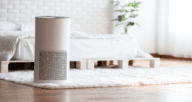What is Sustainable Interior Design — And Why Does It Matter?
- Published on
- 8 min read
-
 Alesandra Dubin, Contributing AuthorClose
Alesandra Dubin, Contributing AuthorClose Alesandra Dubin Contributing Author
Alesandra Dubin Contributing AuthorAlesandra Dubin is a lifestyle journalist and content marketing writer based in Los Angeles. Her vertical specialties include real estate; travel; health and wellness; meetings and events; and parenting. Her work has appeared in Business Insider, Good Housekeeping, TODAY, E!, Parents, and countless other outlets. She holds a master's degree in journalism from NYU.
-
 Richard Haddad, Executive EditorClose
Richard Haddad, Executive EditorClose Richard Haddad Executive Editor
Richard Haddad Executive EditorRichard Haddad is the executive editor of HomeLight.com. He works with an experienced content team that oversees the company’s blog featuring in-depth articles about the home buying and selling process, homeownership news, home care and design tips, and related real estate trends. Previously, he served as an editor and content producer for World Company, Gannett, and Western News & Info, where he also served as news director and director of internet operations.
Sustainable interior design isn’t just about environmental impact. It’s about creating a home environment that holistically supports its residents, their communities, and indeed, the larger global community. That might sound like a tall order for a set of home design choices, but experts underscore the wide-ranging impacts of the undertaking.
If it all sounds daunting — and expensive — consider that sustainable interior design is scalable for all budgets and ambitions. With feedback from experts in sustainable interior design and real estate, here’s a deeper dive into the concept, why it matters, and how to execute it in your own home.

Sustainable interior design: What it is, and what it’s not
Sustainable design has the goal of reducing negative impacts on the environment, and the health and comfort of the building’s occupants, making for a better overall approach to design. According to the U.S. General Services Administration (GSA), the objectives of sustainability are to reduce consumption of non-renewable resources, minimize waste, and create healthy, productive environments.
The GSA explains the core design principles’ aims as follows:
- To optimize site potential (make the home the best it can be)
- To minimize non-renewable energy consumption (opting instead for power sources such as solar or wind)
- To use environmentally preferable products (like sustainable bamboo, for instance)
- To protect and conserve water
- To enhance indoor environmental quality (making the home as healthy as possible for its residents)
- To optimize operational and maintenance practices (streamlining and simplifying maintenance for homeowners over time)
“Sustainable interior design means creating a space with future generations in mind. For example, this might mean selecting durable fabrics in light of what trends are expected in generations to come,” says M+A Architects Interior Designer Katherine Hunter. “Sustainable interior design also means reusing materials that are produced from waste, as well as ethically sourcing products.”
Why sustainable interior design matters
Americans, on average, spend approximately 90% of their time indoors, where the concentrations of some pollutants are often two to five times higher than typical outdoor concentrations, according to data from the Environmental Protection Agency (EPA).
In addition, experts predict that we will spend more time inside with the continued rise of remote work and distance learning. These realities point to the importance of making meaningful changes that will make a difference.
That’s why the significance of sustainable interior design choices aimed at reducing pollutants and improving indoor air quality will only continue to increase. Further, making such choices helps communities much further from home, by reducing incentives for illegal forestation and exploitative labor, for instance.
Overall, sustainable interior design matters both inside the home and has wide-ranging ripples far outside of it, too.

Does it matter when it comes to buying and selling a home?
According to a report by Harvard Business Review, 32% of all U.S. consumers are “Conscious Nonconsumers,” buyers concerned enough about the environment to change their everyday habits. Within this group, 71% say they would pay more for sustainable products.
When it comes to homeowners, an earlier study by UL Environment found that 70% of Americans are looking for greener products in a home, citing concerns about toxic materials and indoor air quality as heavy influences over their choices.
Indeed the EPA says that today’s homebuyers increasingly express concerns over issues like mold, radon, and carbon monoxide. Therefore, investing in these improvements is likely to fetch returns when it’s time to show and sell the home.
“Across industries, we have seen this shift towards sustainability whether related to our buying choices or our lifestyle or routine changes we can make now to lower our individual environmental impact,” says Jaclyn Tracy, founder of the eco-friendly direct-to-consumer marketplace SISTAIN. “So as this awareness increases as a society, so will this market need for eco-friendly and sustainable homes. We will also see an increase in accessible and affordable solutions for creating a more sustainable living space with what you currently have, too.”
Effects on human health for those inside the home
Consumer worries are founded. According to the EPA, irritants and pollutants can impact people living in the home in a variety of ways that might include:
- Irritation of the eyes, nose, and throat
- Headaches, dizziness, and fatigue
- Respiratory diseases, heart disease, and cancer
For instance, radon is a known carcinogen and is the second leading cause of lung cancer. Carbon monoxide is toxic, and even short-term exposure to high carbon monoxide levels indoors can cause death.
Instances of Legionnaires’ disease, a form of pneumonia, have been associated with buildings with poorly maintained air conditioning or heating systems. And plenty of indoor air pollutants are known asthma triggers, such as dust mites, mold, pet dander, tobacco smoke, and cockroach allergens.
Adobe is a sustainable product, an energy-efficient product, and a long-lasting product. Our history and our culture flows through our architecture. It has been a style that has been consistently displayed in the area for hundreds of years, and that’s what makes it so special.
 Jerome Leyba Real Estate AgentClose
Jerome Leyba Real Estate AgentClose Jerome Leyba Real Estate Agent at Keller Williams Currently accepting new clients
Jerome Leyba Real Estate Agent at Keller Williams Currently accepting new clients
- Years of Experience 6
- Transactions 143
- Average Price Point $386k
- Single Family Homes 124
What are examples of sustainable design?
If sustainable interior design sounds high-tech or just plain daunting, consider that some of its principles have already long been at work in many typical residential scenarios.
For instance, carpeting is a great insulator, retaining as much as 10% of the heat in a room that would otherwise be lost, and this, in turn, results in the use of less heat and saving major energy. Similarly, curtains and drapes keep both heat from the sun and cold air out of the home.
When it comes to building materials, sustainable interior design prioritizes renewable materials, like bamboo, which grows quickly. Bamboo makes great flooring and is often found in home furnishings and accessories.
Jerome Leyba, a top-selling agent in the Santa Fe area, explains that local homes have been built with affordable, sustainable adobe for hundreds of years.
“Adobe is a sustainable product, an energy-efficient product, and a long-lasting product,” he says, noting the appealing practical, sustainable qualities have made the building material so enduring. “Our history and our culture flows through our architecture. It has been a style that has been consistently displayed in the area for hundreds of years, and that’s what makes it so special.”

Sustainable interior design tips
Tracy acknowledges, “It is hard to not feel overwhelmed with the thought of overhauling your entire living space to be more eco-friendly.” But the good news is, she says, “Luckily, as the industry holistically shifts towards sustainability, easy and affordable solutions are popping up that consumers can make now to generate a greater collective impact later.”
This means choosing from among abundantly available and environmentally friendly materials for furniture, flooring and rugs, and more, such as reclaimed wood, sustainable bamboo, recycled metal and plastic, and jute, which “acts as a natural heat insulator, so look for this fiber in your area rugs too to reduce your home’s energy use.”
Other simple, doable tips for making your living space more eco-friendly include:
- Replace appliances with EnergyStar models
- Invest in products with sustainability certifications and circular initiatives
- Evaluate your approach to waste management, such as composting
- Search for antiques and vintage finds
“Resale is a huge market right now,” Tracy says.
Note that it doesn’t have to be expensive to implement a sustainable interior design strategy. “Many traditional finishes are relatively cost effective,” Leyba notes of materials such as the affordable adobe in such widespread use in the Santa Fe market.
Architecture, engineering, and construction design expert Anthony Carrino (also known for his HGTV show Kitchen Cousins), explains that implementing sustainable interior design “Can cost anywhere from a few dollars to multiple thousands of dollars depending on how large the project is and how committed to sustainability you are. Not all sustainable products are more expensive, although that is the trend. Prices are coming down as technologies and scale improve, so I encourage you to do the research.”
Conclusion
Sustainable interior design is about making an environmentally friendlier impact at home while creating a residential atmosphere that’s healthy and comfortable. It’s about incorporating sustainable, renewable designs and materials for the benefit of occupants and the global community alike — but it doesn’t have to be high-tech or expensive.
Consider taking the first steps today for a beautiful, health-supporting home that will also be desirable to future buyers who are increasingly seeking out these choices.
»Learn more: See HomeLight’s blog for more design tips and trends
Header Image: Reuse of fire hoses found in the basement of an 1896 firehouse as a backlit art installation coming up the stairs. (Source: Anthony Carrino)
- "Sustainable Design," U.S. General Services Administration (September 2023)
- "Indoor Air Quality," United States Environmental Protection Agency (July 2023)
- "How Brands Can Sell to Environmentally Conscious Nonconsumers," Harvard Business Review (June 2023)
- "Benefits and Features of Indoor airPLUS Homes," United States Environmental Protection Agency (October 2023)
- "Radon," United States Environmental Protection Agency (October 2023)
- "Carbon Monoxide Poisoning," Centers for Disease Control and Prevention (March 2023)
- "Indoor Pollutants and Sources," United States Environmental Protection Agency (February2023)
- "What is Jute Fabric: Properties, How its Made and Where," Sewport (November 2023)
- "The Treehugger Guide to Sustainable Certifications," Treehugger (August 2022)




